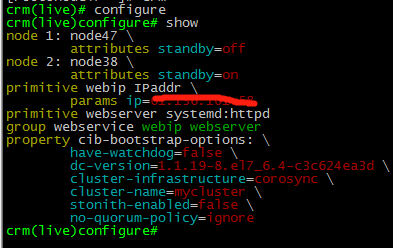准备2台机器,3个ip
node01 192.168.1.10 #节点1 node02 192.168.1.11 #节点2
#准备一个IP,作为虚拟ip
vip 192.168.1.88
建立互通并安装软件
#关闭两台防火墙
systemctl disable firewalld
systemctl stop firewalld
#在/etc/selinux/config中把enforcing设为disable
enforcing=disable
#在node01,和node02中建立修改hosts
192.168.1.10 node01
192.168.1.11 node02
root@node01:~#ssh-keygen #一直回车
root@node01:~#ssh-copy-id node01 #建立自己互通1、输入yes 2、输入node1的密码
root@node01:~#ssh-copy-id node02 #建立node02的互通1、输入yes 2、输入node2的密码
#在node02上重复上面操作
#建立crmshyum源
root@node01:~#vi /etc/yum.repos.d/crm.repo
name=Stable High Availability/Clustering packages (CentOS_CentOS-7)
type=rpm-md
baseurl=http://download.opensuse.org/repositories/network:/ha-clustering:/Stable/CentOS_CentOS-7/
gpgcheck=1
gpgkey=http://download.opensuse.org/repositories/network:/ha-clustering:/Stable/CentOS_CentOS-7/repodata/repomd.xml.key
enabled=1
root@node01:~# yum install -y corosync pacemaker crmsh
#两台机器同样操作
至此安装完毕修改/corosync.conf
root@node01:~#vi /etc/corosync/corosync.conf
totem {
version: 2
crypto_cipher: none
crypto_hash: none
interface {
ringnumber: 0
bindnetaddr: 192.168.1.0
mcastaddr: 239.255.1.1
mcastport: 5405
ttl: 1
}
}
logging {
fileline: off
to_stderr: no
to_logfile: yes
logfile: /var/log/cluster/corosync.log
to_syslog: yes
debug: off
timestamp: on
logger_subsys {
subsys: QUORUM
debug: off
}
}
quorum {
provider: corosync_votequorum
two_node: 1
}
nodelist{
node{
ring0_addr:192.168.1.10
nodeid: 1
}
node{
ring0_addr:192.168.1.11
nodeid:2
}
}
service {
ver: 0
name: pacemaker
}
#同步node02代码如下
root@node01:~# scp /ect/corosync/corosync.conf node02:/etc/corosync
corosync配置完毕,启动corosync
root@node01:~# systemctl start corosync root@node01:~# systemctl enable corosync root@node01:~# systemctl start pacemaker root@node01:~# systemctl enable packmaker node02同样操作 root@node02:~# systemctl start corosync root@node02:~# systemctl enable corosync root@node02:~# systemctl start pacemaker root@node02:~# systemctl enable packmaker
查看一下corosync状态
root@node01:~#crm_mon
为两个节点安装httpd
root@node01:~#yum install httpd -y root@node01:~#systemctl start httpd root@node01:~#echo '<h1>192.168.1.10<h1>' > /etc/www/html/index.html root@node01:~#curl 192.168.1.10 <h1>192.168.1.10</h1>
root@node02:~#yum install httpd -y root@node02:~#systemctl start httpd root@node02:~#echo '<h1>192.168.1.11<h1>' > /etc/www/html/index.html root@node02:~#curl 192.168.1.11 <h1>192.168.1.11</h1>
配置站点

可在configure里面直接输入edit,可直接编辑此配置文件
root@node01:~#crm_mon 此命令可查看corosync状态
primitive webip ocf:heartbeat:IPaddr params ip=192.168.1.88#添加虚拟ip primitive webserver systemd:httpd #添加容器 group webservice webip webserver #建立一个组,把上面的两个放进去 如果需要删除上面的内容。 请先到crm(live)#node里面执行stop webserver或者webservice或者webip然后再到configure里面delete webserver或者webservice或者webip standby node02#手工设置一个掉线节点 online node02#上线一个节点 具体可以参考crm命令的使用。 你还可以用pcs进去集群管理
就写到这里吧,以后有时间再补充